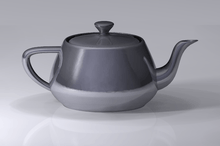Martin Newell (computer scientist)
| Martin Edward Newell | |
|---|---|
| Nationality |
English American |
| Institutions |
CADCentre University of Utah Xerox PARC Ashlar Adobe |
| Alma mater | University of Utah |
| Thesis | The Utilization of Procedure Models in Digital Image Synthesis (1975) |
| Known for |
Utah Teapot[1] Newell's algorithm |
| Notable awards | Elected member of the National Academy of Engineering |
|
Website academic | |
Martin Edward Newell is a British-born computer scientist specializing in computer graphics who is perhaps best known as the creator of the Utah teapot computer model.
Career
Before emigrating to the USA, he worked at what was then the Computer-Aided Design Centre (CADCentre) in Cambridge, UK,[2] along with his brother Dr. Richard (Dick) Newell (who went on to co-found two of the most important UK graphics software companies - Cambridge Interactive Systems (CIS) in 1977 and Smallworld in 1987). At CADCentre, the two Newells and Tom Sancha developed Newell's algorithm, a technique for eliminating cyclic dependencies when ordering polygons to be drawn by a computer graphics system.[3][4][5]

Newell developed the Utah teapot while working on a Ph.D. at the University of Utah,[1][6] where he also helped develop a version of the painter's algorithm for rendering. He graduated in 1975, and was on the Utah faculty from 1977 to 1979.[7] Later he worked at Xerox PARC, where he worked on JaM, a predecessor of PostScript. JaM stood for "John and Martin" - the John was John Warnock, co-founder of Adobe Systems.[8]
He founded the computer-aided design software company Ashlar in 1988.[7] In 2007 Martin Newell was elected to the National Academy of Engineering.[9] He recently retired as an Adobe Fellow at Adobe Systems.
References
- 1 2 Torrence, A. (2006). "Martin Newell's original teapot". ACM SIGGRAPH 2006 Teapot on - SIGGRAPH '06. p. 29. doi:10.1145/1180098.1180128. ISBN 1595933646.
- ↑ van Dam, Andries (1998), "Some Personal Recollections on Graphics Standards", SIGGRAPH Computer Graphics Newsletter, 32 (1).
- ↑ Sutherland, E. E.; Sproull, R. F.; Schumacker, R. A. (1974). "A Characterization of Ten Hidden-Surface Algorithms". ACM Computing Surveys. 6: 1. doi:10.1145/356625.356626.
- ↑ Newell, M. E.; Newell, R. G.; Sancha, T. L. (1972). "A solution to the hidden surface problem". Proceedings of the ACM annual conference on - ACM'72. 1. p. 443. doi:10.1145/800193.569954.
- ↑ List of publications from Microsoft Academic Search
- ↑ Newell, Martin (1975). The Utilization of Procedure Models in Digital Image Synthesis (PhD thesis). University of Utah.
- 1 2 History of the University of Utah School of Computing, retrieved 2010-01-26.
- ↑ Adobe Co-founder John Warnock on the Competitive Advantages of Aesthetics and the 'Right' Technology, Knowledge@Wharton, The Wharton School, January 20, 2010.
- ↑ Dr. Martin E. Newell in the NAE Members Directory, retrieved 2014-06-27.